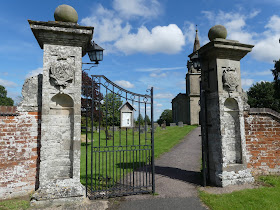I bribed D recently with the promise of a farm shop visit if he'd come to a Warwickshire church with me.
I've wanted to visit St John the Baptist at Honiley for quite some time. It was built in 1723 by John Saunders of Honiley Hall. So the 300th anniversary is being celebrated at the church this year.
The church is built of local pale sandstone and there is evidence of the site being used as a place of worship for centuries.
It is dedicated to St John the Baptist due to the presence of an ancient holy well called St John's located in a nearby field. (I couldn't find a way to access the field unfortunately but I understand not much remains of the well but a trickle of water and possibly a few bricks). Local legend suggests the site was a place of pilgrimage where early converts to Christianity were baptised and the water of the well was said to have healing powers.
The gate piers at the entrance bear the arms of John Saunders.
The West Tower is Baroque and is topped by an octagonal spire with a ball and weather vane. Elements of the church reminded me very much of Birmingham Cathedral.
It is not known for certain who designed and built the church but there are various contenders:
- Sir Christopher Wren or his son due to their ownership of the nearby Wroxall estate from 1713. A local story tells of Sir Christopher drawing a plan for the church on the table cloth when he dined at John Saunders!
- Smiths of Warwick
- Thomas Eayre of Kettering, designer of the classical church at Stoke Doyle, Northants 1722-25 who cast the Honiley bells in 1731.
To my surprise D announced that the church was actually open adding the ominous words it does not appear to be your type of church. (I am not that keen on Georgian churches - give me a Medieval church any day). But when I peeked through the door I had a slight "Wow!" moment when I saw the stained glass in the apse.
Font from 1723
Looking toward the east end of the church with boxed pews and THAT stained glass.
The West Gallery is supported by Corinthinian columns.
Memorial to a descendant of John Saunders and below a memorial to Herbert and Lily Wade who lived at Honiley Hall in the 20th Century.
Oak pulpit from 1723
Apse
The beautiful stained glass is by Theodora Salusbury and the windows were installed in 1924 and 1926.
The main window which depicts the Virgin and Child was commissioned by Lily Wade of the newly built Honiley Hall in memory of her late husband Herbert.
Here you can see the peacock - the signature of Theodora Salusbury.
The remaining two windows depicting "Angels in Adoration" were commissioned in 1926 by the two sons - Charles and Dennis.
Carvings on the pews - the first one depicts an elephant head the insignia of John Saunders.
This basin in the porch may once have been used as a font.
Graffitti in the porch - I always find it fascinating to read when I spot it.
The current Honiley Hall in the distance.
The original Honiley Hall built by John Saunders has been demolished but two service wings remain. On the north side of the church are the Malthouse and North Lodge and on the south side (2nd photo) the South Lodge and Parson's Lodge. The church really is in a lovely setting.
The pub in Honiley known for years and years as the Boot has changed names! I've searched for a ghost story about phantom coachmen and Honiley but the only mention I can find is one set in Coventry which is not that close!
Some years ago I found another window by Theodora Salusbury in Knowle Parish church.
Theodora Salusbury (1875-1956) was born in Leicester and was an artist and craftswoman in the Arts and Crafts style. After training she worked from her studios in Cornwall as a stained glass artist. She designed windows for about 30 churches mainly in the years between World War One and Two. Her signature was a peacock.
It was a lovely afternoon out and we stopped off at the farmshop in Balsall Common on the way home.
We are continuing to have massive problems with the rebuilding work next door - the situation is just getting worse and worse. We have discovered that his neighbours the other side are having even more problems than us! I would love to share with you but for the moment as this blog is not private it probably wouldn't be wise!!!
I hope everyone is staying safe and well.
All photos taken by me with the Panasonic Lumix FZ330 bridge camera (I don't particularly rate my photos but if anyone wishes to use one I would be grateful for an email first - thanks)
Reference: Church Guide Book
Pevsner "Buildings of England Warwickshire" Nikolaus Pevsner and Chris Pickford - Yale University Press 2016





















































